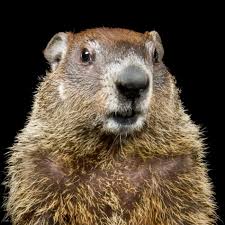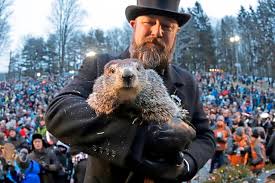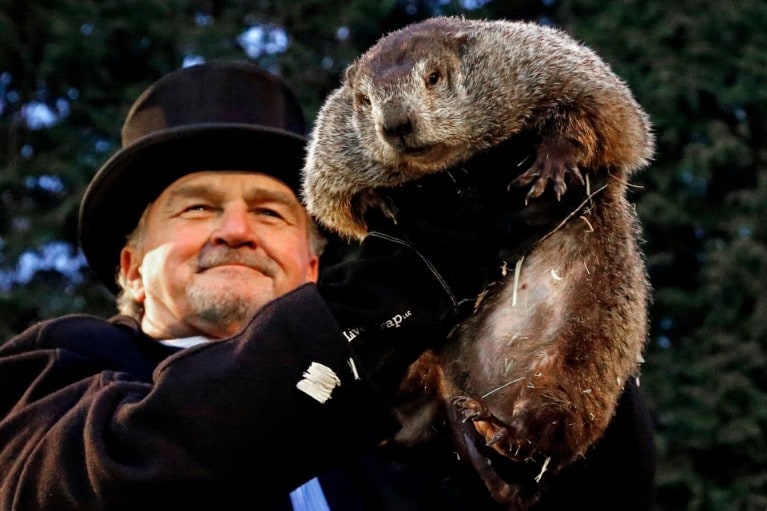Every year on February 2nd, thousands of people gather together in Gobbler’s Knob in Punxsutawney, Pennsylvania to see the groundhog, Punxsutawney Phil, emerge from his burrow to predict the weather. But how accurate is this strange tradition?
--Leah Upton, 8th grade

Every year on February 2nd, thousands of people gather together in Gobbler’s Knob in Punxsutawney, Pennsylvania to see the groundhog, Punxsutawney Phil, emerge from his burrow. The tradition is that the presence (or absence) of the groundhog's shadow predicts when spring arrives.
Groundhog Day became more popular from the film Groundhog Day. In the movie, Phil Connors, a bitter weatherman (played by Bill Murray), wakes up on Groundhog Day and continues to relive the day over and over again. This movie gives a new meaning to Groundhog Day and popularizes the otherwise irrelevant holiday for people who don’t live in Pennsylvania.
Groundhog Day became more popular from the film Groundhog Day. In the movie, Phil Connors, a bitter weatherman (played by Bill Murray), wakes up on Groundhog Day and continues to relive the day over and over again. This movie gives a new meaning to Groundhog Day and popularizes the otherwise irrelevant holiday for people who don’t live in Pennsylvania.

For the most part, people agree that Groundhog Day is just a pointless tradition. “I think that Phil is cute and we love Phil, but Phil needs to get a different job,” says Grace Triantafyllos, an 8th grader at OSA. Triantafyllos believes that Groundhog Day is a fun tradition, but it isn’t necessary. “It's cute, but why do you need this groundhog to tell you what to do with your life? What does this groundhog know about anything?”
Most people are unaware when it comes to obscure holidays like Groundhog Day. “I really understood it more when I watched the popular movie, Groundhog Day,” explains Francis Upton, a software technician who, like many others, only knows about the holiday from the film.
Upton also added, “It affects me because it created this great movie that I love.”
According to TimeandDate.com, thousands of years ago, people in an area of Europe which is known today as Germany, believed that the badger had the power to predict the coming of spring. They used the badgers’ “powers” to determine when they should plant their crops. When people from Germany started to settle in Pennsylvania, they wanted to continue their tradition, but there was a lack of badgers in the area. They agreed to replace the badger with a groundhog. If the groundhog sees its shadow on February 2nd, it will be frightened by it and return to its burrow, indicating that there will be six more weeks of winter. If it does not see its shadow, then an early spring is on the way.
Most people are unaware when it comes to obscure holidays like Groundhog Day. “I really understood it more when I watched the popular movie, Groundhog Day,” explains Francis Upton, a software technician who, like many others, only knows about the holiday from the film.
Upton also added, “It affects me because it created this great movie that I love.”
According to TimeandDate.com, thousands of years ago, people in an area of Europe which is known today as Germany, believed that the badger had the power to predict the coming of spring. They used the badgers’ “powers” to determine when they should plant their crops. When people from Germany started to settle in Pennsylvania, they wanted to continue their tradition, but there was a lack of badgers in the area. They agreed to replace the badger with a groundhog. If the groundhog sees its shadow on February 2nd, it will be frightened by it and return to its burrow, indicating that there will be six more weeks of winter. If it does not see its shadow, then an early spring is on the way.

According to EarthSky, Groundhog Day is on a cross-quarter day, about midway between the December solstice and March equinox. For the ancient Celts, cross-quarter days signaled the beginning of a season. Almanac.com explains how if it was a sunny day and the groundhog sees his shadow, the Celtics knew that it would be cold and snowy, but if it was cloudy day, they planted their crops because that meant spring would come early. February 2nd is the very first cross-quarter day of the year, and there are four cross-quarter days in total, including Halloween. Our ancestors who started Groundhog Day were very aware of the sun's movement, because their crops depended on it. So, on February 2nd, they would use a groundhog to determine the seasons’ changes. That's what our ancestors believed, but in reality it's all a coincidence.
But how accurate is this strange tradition? According to Scholastic.com the groundhogs predictions are only right 39 percent of the time. So despite all the fuss about this little critter, Phil is more likely to be wrong than right.
But how accurate is this strange tradition? According to Scholastic.com the groundhogs predictions are only right 39 percent of the time. So despite all the fuss about this little critter, Phil is more likely to be wrong than right.


